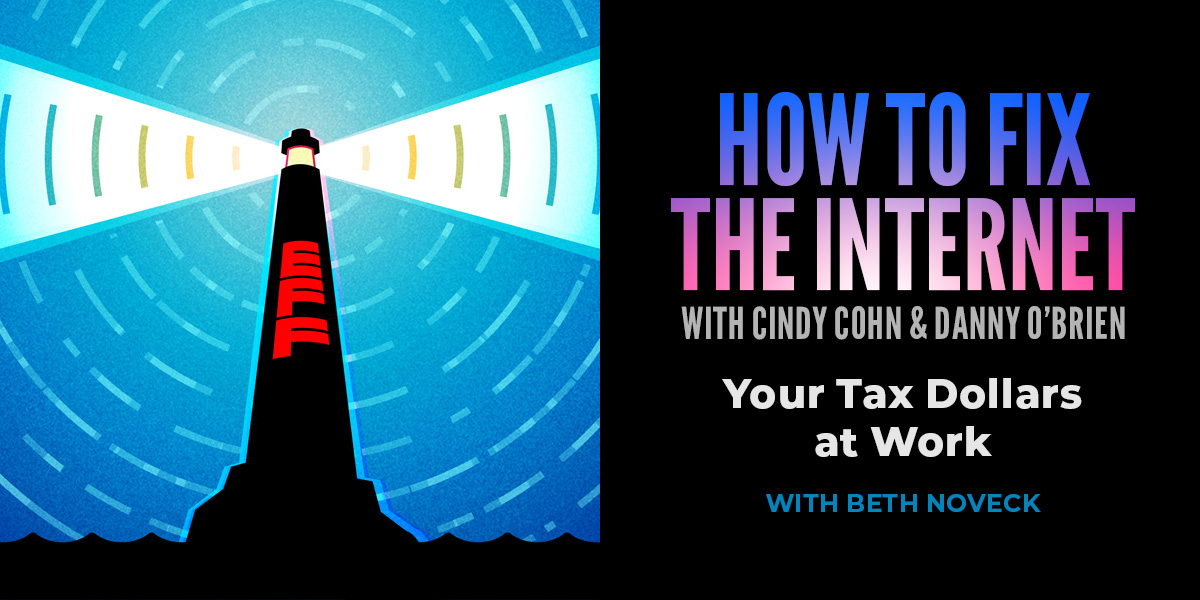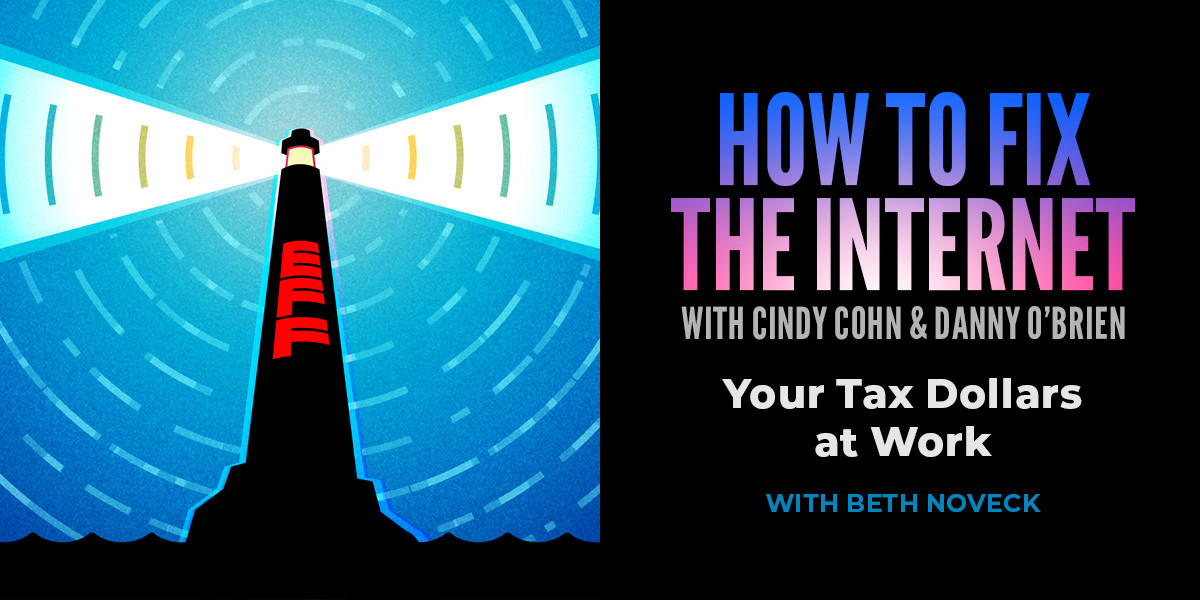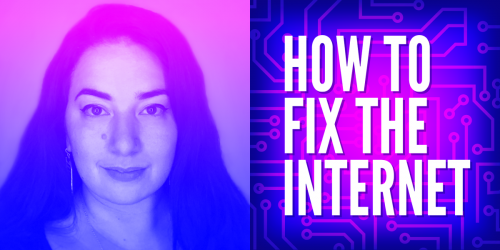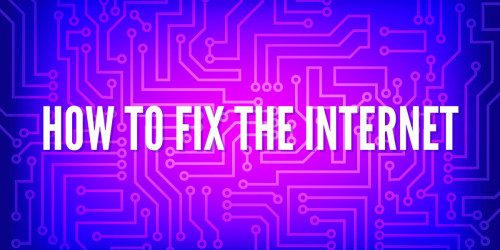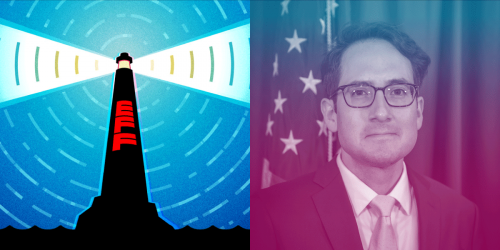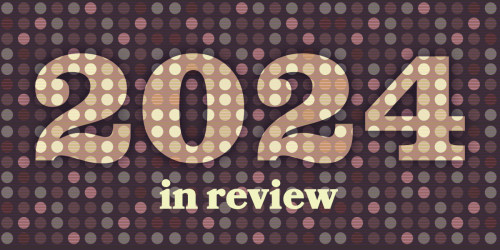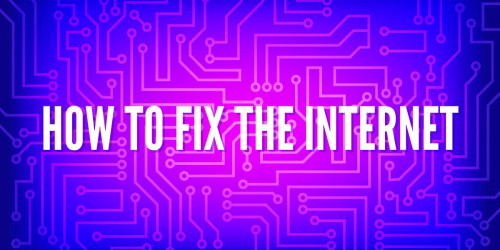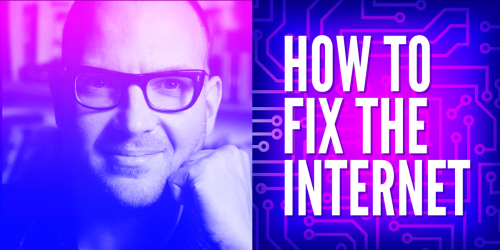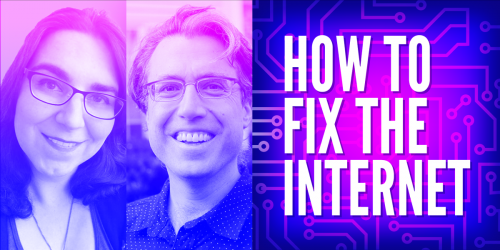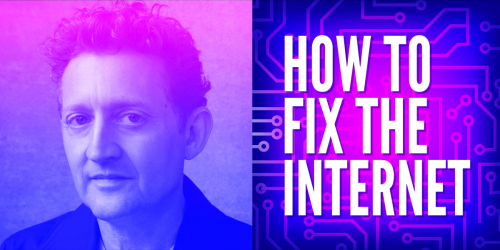Democracy means allowing everyday people to have their voices heard on public matters involving their communities. One of the goals of civic technology is to allow a more diverse group of people to have input on government affairs through the use of technology and the internet.
Beth Noveck, author of Solving Public Problems and Director of the Governance Lab, chats with EFF's Cindy Cohn and Danny O'Brien about how civic technology can enhance people's relationship with the government and help improve their communities.

![]()
![]()
![]()

You can also listen to this episode on the Internet Archive and on YouTube.
One challenge that governments have is finding out what problems are plaguing their citizens and then figuring out how to solve them. But without input from community members, governments can't figure out what problem they are trying to solve. One of the promises of civic technology is to allow for a more diverse group of citizens, from those who cannot attend in-person forums to marginalized communities, to raise awareness about problems in their areas, and offer solutions that they believe would be beneficial.
"It really helps when we can show how citizen engagement can actually lead to diverse people giving useful contributions that can actually help to inform a process"
But, as Beth explains, governments have some work to do to allow this civic technology to work—from educating or hiring government officials who know how to use this technology to ensuring that communities know these outlets exist.
In this episode you’ll learn about:
- What civic technology is and how it can be used to approach and fix public problems while enhancing the relationship between people and their government.
- The importance of deciding what problem you are trying to solve before working on a solution.
- Ways that civic technology can ensure that the government is held accountable for its actions.
- How we can build civic technology tools to increase inclusion, specifically for those who have been marginalized or previously left out of the conversation.
- Why civic technology allows for more people to get engaged in their democracy.
- The good and bad that can come with governments increasing their knowledge of technology.
Beth Noveck is a professor at Northeastern University, where she directs the Burnes Family Center for Social Change and Impact and its partner project, The Governance Lab (The GovLab). She is the author of Solving Public Problems: How to Fix Our Government and Change Our World. You can find Beth on Twitter @bethnoveck
If you have any feedback on this episode, please email podcast@eff.org.
Music
Music for How to Fix the Internet was created for us by Reed Mathis and Nat Keefe of BeatMower.
This podcast is licensed Creative Commons Attribution 4.0 International, and includes the following music licensed Creative Commons Attribution 3.0 Unported by their creators:
- Drops of H2O (The Filtered Water Treatment ) by J.Lang Ft: Airtone
http://dig.ccmixter.org/files/djlang59/37792 - Xena's Kiss / Medea's Kiss by mwic
http://dig.ccmixter.org/files/mwic/58883 - Kalte Ohren by Alex Ft: starfrosch & Jerry Spoon
http://dig.ccmixter.org/files/AlexBeroza/59612 - Come Inside by Snowflake Ft: Starfrosch, Jerry Spoon, Kara Square, spinningmerkaba
http://dig.ccmixter.org/files/snowflake/59564rr4 - Come Inside by Zep Hurme Ft: snowflake
http://dig.ccmixter.org/files/zep_hurme/59681
Transcript
Beth: Lakewood, Colorado. Community of about, I think 110,000, 120,000 people outside of Denver where they have one urban planner. So he was getting really tired of saying to people, "Sorry, I can't do much more about climate change. Sorry, I can't do much more about sustainability. I'm just one guy." So instead what he did was turn to the internet to organize and crowdsource what ended up being 20,000 residents to run what has become 500 different sustainability projects in the community of Lakewood, and now they've replicated it across four cities in Colorado.
Cindy: That's Beth Noveck. She's one of the leading thinkers on how we can use technology to make government and democracy better. Beth's most recent book is called Solving Public Problems.
Danny: Beth is a professor at Northeastern University and the Director of the Governance Lab and also the Chief Innovation Officer for the state of New Jersey. Today, we're going to talk to Beth about how government can get better input from citizens and how we can leverage technology that the government uses to improve our lives and our democracy.
Cindy: I'm Cindy Cohn, EFF's Executive Director.
Danny: And I'm Danny O'Brien special advisor to EFF. Welcome to How to Fix the Internet, a podcast of the Electronic Frontier Foundation.
Cindy: Beth, thank you so much for coming on our program.
Beth: Hi, it's great to be here. I'm just delighted.
Cindy: Well, we've talked on this podcast a lot about the dangers of government using technology tools that can add to discrimination, to racism, to other societal problems. And one thing I really like about your work is that you're really focusing on how we can approach public problems better. Can you give us an example of this?
Beth: Oh, goodness. Yes. I mean, first of all, the work that you do is so important to protect us from all the dangers, both from technology and from the government's overreach into technology. But because you have that field so well covered, I think it's very important that some of the rest of us also focus on the positive applications for technology as many social innovators, civic tech users, and programmers actually do, which is looking at how can we use technology to improve how government works to fix public problems, to deepen democracy.
I think we saw a lot of that during COVID, So whether it's the symptom trackers that allowed, for example, over three quarters of a million people in New Jersey to actually track their own symptoms and then be able to know what do I do about it, whether I have a cough or a cold or a sneeze or a fever, but at the same time to contribute data back into the process. So I think if we weren't aware of it before, and there are plenty of examples I can give you from pre COVID. I think all of us have become sadly aware of the role that data and technology can play in really saving lives as it's done during the pandemic.
Cindy: This is one of the areas where EFF was pretty involved in the early days with some of these trackers and to try to keep them focused on the problem and not have issue creep. Because one of the things we know is that if you build it, they will come. If you gather a bunch of data about humans, people are going to find, and governments are going to find lots of uses for it. And trying to cabin this to the specific health crisis was something that I know you did some of, and we did a lot of as well.
Beth: Those issues about responsible uses of tech and data that actually safeguard privacy, that treat people ethically and humanely are hugely important. I do think that there is a significant problem with what Evgeny Morozov used to call solutionism. The idea that if we build it, they will come. That there's an app for that, that you can create the solution. What I find in the work that I do is that far too often, we are building solutions without being clear on the problem that we're trying to solve.
And so the really good uses of tech and data are ones that start, first and foremost, by defining the problem that we're trying to solve. So let me give you a quick example, sticking with COVID for a moment here although I think we'd all like to stop talking about COVID.
Cindy: One day.
Beth: One day.
Beth: One day. I hope that I'm dating this conversation, that COVID will be in the rear view mirror at some point. But if we're talking about things like why people do or don't wear masks, if the problem is that you're giving out masks because you think masks are too expensive for people to wear, for example. That's a solution, but only to one problem. If the root cause of the reason why people aren't wearing masks is because politicians are telling them that COVID doesn't exist, or politicians are telling them that wearing masks is somehow a virtue signal of the wrong politics, then simply giving out more masks is not going to be the solution. So I think that's a stark example, but we need to really focus on what the root causes of the problem are so that we can come up with solutions, especially tech solutions.
But we need to really focus on what the root causes of the problem are so that we can come up with solutions, especially tech solutions.
Cindy: That's an area where you've done a lot of thinking. I think of this as how do you get citizen input into governmental questions? That's something I know you've thought a lot about, and you've got some good examples of I'd love for you to talk about some of those.
Beth: The best way to understand the problem and therefore to build the right solutions is to talk to actual humans about what they need. What designers like to call human centered design. What we used to just call citizen engagement, frankly, or public engagement. But we're seeing some pretty exciting examples in the civic tech world of ways in which institutions are turning to technology to make that engagement with citizens easier.
So again, there's lots of wrong uses or undeveloped and unfulfilled uses. You guys will know, but maybe not everybody here knows that since 1946, we've had a law in this country that has encouraged citizens to comment on regulatory rule making. But in the past, Congress would pass a few hundred at most pieces of legislation a year. Regulatory agencies passed thousands of regulations about everything from clean air, to clean water, to the width of doorways, to make them wide enough for a wheelchair to get through, or last year there was rulemaking on ceiling fans.
I mean, every aspect of life is governed by regulatory agencies at the federal or state level and you had a right to put participate. But for the last 20 years, the federal government in particular has turned to using new technology to create a website called Regulations.gov, where you can comment. Still nobody knows about it. Nobody uses it. It's not very well designed. It leads sometimes to hundreds of thousands of comments.
Some of you may have commented for example, on the FCC's net neutrality rule making a few years ago, or maybe on snowmobiles in national parks a few years before that. But there's lots of new examples of where people are turning to new technology, including machine learning to make those engagement processes much, much, much more relevant and I think to create new opportunities for people to do things.
Cindy: EFF sent a lot of people to that Network Neutrality rulemaking and, it was also filled with fraudulent entries too but overall it was ignored by the FCC at the time, led by Ajit Pai. So civic tech that doesn’t work or doesn’t actually result in government listening can in some ways be worse than no tech at all.
Danny: That involvement is not evenly spread out – if we use a tech based involvement tool, then some issues like net neutrality will attract lots of input, while others don’t.
Beth: In Helsinki, they developed civic tech. Actually, a global civic tech group developed a series of tools to help the city to create 147 different sustainability goals to have full data transparency about how the city is accomplishing those goals, to get citizens to give input on those sustainability projects and to hold the government accountable. These are just some examples of the ways in which I think the most progressive and forward thinking institutions are turning to new technology to really tap not just a wisdom of the crowd in traditional ways that we've thought about it, like giving comments on a rule, but actually to take action.
Danny: There's a huge chunk of my mind that's cheering you on at this point, because I've always enjoyed this use of technology in government and this is what the internet was expected to do. I know as an activist everybody is competing to give greater visibility to their cause as they should in these consultations. But it ends with a real risk of a distortion of what's being said. For instance, people who don't have access to this technology, don't get to have a proportion of voice in that. Is that something that you think has progressed and solutions are beginning to, coming to appear to tackle that?
Beth: So you're absolutely right again that we need to be critical about how we do these things. Design matters. Not all participation is created equal. So, for example, there's really great intentions in the city of Madrid. They were really path breaking after the occupying movements around the world and student protests in Madrid, they created a platform called Decide Madrid which it does two things. One is it helps do participatory budgeting where citizens can dictate some portion of the budget. Should we build a soccer pitch or a playground or a school in my neighborhood. And that works pretty well, but they had this component where citizens can propose legislation to the city council. So they had 400,000 people sign up for this. That's a huge number of people. A lot of goodwill and effort. And in the first few years of this project, the number of citizen proposals that actually turned into legislation?
Cindy: Zero.
Beth: Correct. Zero. It's not because of bad intentions. It's not because of lobbyist manipulation. It's not the malfeasance problem. It's just a really badly designed process, both legally and technically, it doesn't work very well. And then on top of that, to your earlier point, I think so many of us in the civic tech community, especially before George Floyd and the Black Lives Matter protests, we’re very content to focus on building something. Again, if we build it, they'll come and not really look at who's coming and who's showing up.
Cindy: I think that's a good point; it's important that we build civic tech tools in a way that increases inclusion, and especially increases the inclusion of people who have too often been marginalized or left out of the conversation, whether because of their race or language skills or where they live or economic background.
Danny: So what are the incentives for governments to do this right?
Beth: So first and foremost, the best incentive, both for government and for citizens is that it's relevant. So it's got to be useful. We for a long time thought about engagement as a nice to have as a democratic right and value, but let me analogize here to the world of open data. As somebody who's worked in the open data and transparency field for a long time, many of us argued opening up government data is the right thing to do. But it was when we shifted to begin to explain to political leaders that open data actually helps us to solve problems.
But I think it really helps the selling point when we can show how citizen engagement can actually lead to diverse people, giving useful contributions that can actually help to inform a process.
And when you can construct a process that's actually manageable and efficient for well intentioned, often public servants, but who don't only have so many hours in the day, that it actually works. It works well. We get good ideas. We get good contributions. It's why participatory budgeting has taken off and is now in 1500 communities around the world because it's an efficient, easy to manage process that leads to real outcomes. You get a decision at the end of it about how do we spend X% of the budget. And as a result, many, many cities have dramatically increased 10X the budgets that they're actually devoting to these citizen feedback processes, because it just works well, it’s efficient, and it fits within a 9:00 to 5:00 day.
Danny: “How to Fix the Internet” is supported by The Alfred P. Sloan Foundation’s Program in Public Understanding of Science. Enriching people’s lives through a keener appreciation of our increasingly technological world and portraying the complex humanity of scientists, engineers, and mathematicians.
Cindy: Let's go to this good future. Let's say that these ideas end up getting implemented across the United States and around the world. What would it look like for me as a citizen or me as a governmental official in some place?
Beth: So let me say I am relentlessly optimistic or I wouldn't get out of bed. Again, I want to double down on just the fact that that's why my contribution dollars go to EFF to ensure the basic preconditions of free internet and freedom of speech and civil liberties that allow us to imagine this future. Without those preconditions, we don't get the future that I'm talking about.
Beth: So the future looks like the opportunity for more of us to get engaged in the life of our democracy and the life of our government in ways that we want to around the topics that interest us, not as a one size fits all. You may remember early experiments in the US and the UK and elsewhere with things like E-petitions. Didn't really work very well, but just the concept that you could say, "Hey, here's what I want you to focus on and sign your name to it." And yes, people suggested goofy stuff like we should build a death star or the most popular petition. Do you remember what it was?
Cindy: I think it was marijuana legalization. Wasn't it?
Beth: Incorrect, that was the second or third most popular. The first popular was we should deport Justin Bieber back to Canada. The second most popular was the death star. And I believe, and forgive me, I may have my data wrong here in the top three was marijuana legalization. I do think it was an important, not the Justin Bieber one, but the marijuana petitions were really important as far as signaling how public opinion had changed on that issue and did significantly contribute to the subsequent legalization of marijuana and the decriminalization of marijuana across so many states in the United States.
So coming back to your question on what does the future look like? It's lots of different ways of getting involved, knowing what those ways are and knowing the ways in which those can make a difference in your city.
So quick example here. I did some work with my colleagues in Mexico, where we worked with the city of San Pedro Garza García, Mexico on running a process whereby citizens were asked to co-design solutions to urban challenges with the city. It was so successful because it was efficient, it led to real outcomes to projects that got implemented that led to new green spaces, reducing the amount of people commuting to school, a new commuting plan that was designed to promote carpooling, new green spaces, all kinds of things around trash.
What led to was then the city going... We really like this, because it helps us to get in better ideas to get citizens engaged in collective action to do things in their own community and it's more effective. So we're going to institutionalize it in legislation and make this one of the core ways that we do business.
Cindy: I hear you really loud and strong. What you have to do is you have to show the community and the governmental officials that for the governmental officials, it makes things easier and you do things better. And for the citizenry that if you invest the time, it'll be worth it. I'm wondering if you've seen some good examples of how to get maybe more marginalized people to be able to participate. People who may be working a couple of jobs, have a couple of kids and don't have a lot of extra time to take on a another job.
Beth: So we've had a lot of conversations over the years about the ways in which tech can be exclusionary because of the digital divide and wanting to ensure that people have face-to-face opportunities. But the other side of that coin is that in fact, for busy people who have to take care of an elderly parent or a small child and who work a job, or increasingly two jobs, technology actually provides an opportunity for greater equity. I worked on a project in the last year together with the New Jersey Department of Education to ask what ended up in close to 20,000 parents, students and teachers about the major challenges that they're facing. What to them are the most important issues in connection with education during COVID. So to do that process, we did three kinds of engagement. First, we ran an open engagement, using a simple open source platform, called All Our Ideas. We made it anonymous to participate because a lot of people don't want to give the government a lot of information about themselves and they want to be able to speak freely. And we wanted to create something that was very fast. So then we ran another process whereby we selected a representative sample, but we didn't just go representative. We said, knowing the disparate impacts of COVID on black and brown communities, we over sampled so that we had 50% black and brown participants over selecting for people who came from school districts that had a disproportionate number of children receiving free school lunch or school breakfast.
And to ensure that it was equitable and fair, we paid people for their participation because we asked an hour of their time in that case to have what amounted to you can think about it as a focus group on steroids that used machine learning to actually be able to sort what people told us very, very rapidly and be able to visualize and help you see what people's opinions were and to sort it based on different demographics.
And to organize all of this, we recruited again, a representative sample of 20 kids from around the country to design and run the program. It was a program about education after all and about schools. So who are the most experts, but kids? So it would be foolish not to include them and their perspective.
So I think long story short, it's about paying people for their time and it's about ensuring that we combine representativeness with self selection.
Danny: I think certainly a few years ago, it was the case that there was a real knowledge gap, I think, in governments all around the world. I do feel that's changed.
Part of the way that changed was with the Obama administration, really picking and running with the idea of bringing in people from the tech industry, but that's has its downsides too because they're, they're kind of a constituency of their own and you really don't want in this particular age, government and big tech to be the same people or friendly together. Do you think governments are getting better at having that tech knowledge and is that tech knowledge helping or hindering their ability to regulate and control big tech?
Beth: The white house, having a chief technology officer and a chief information officer then led to agencies creating those roles that trickle down into states creating those roles and local governments creating things like my job as chief innovation officer and cities doing the same thing. So there is a proliferation. There's much better talent. There's much more of an appreciation for the need for that talent and for those skills than there's ever been before. But we need those skills to be much, much more widespread. And to your point, Danny, we don't want it just to be a revolving door between Silicon Valley and Washington. We want to have those skills be much more dispersed and to be shared by people who have different kinds of background and training.
But right now our government, which is the largest employer in the country as the public sector, doesn't have any requirement that people need to know anything about the internet, or need to know anything about tech or need to know anything about data. I think that needs to change. We need to make those skills much, much more distributed just as we need to get more people into these roles in government at the same time.
Cindy: I know you've done a lot of thinking about skills sharing and other kinds of things, and the idea that we shouldn't take government employees as they are when they first get hired, but we should really have paths forward for them to get more skills in this area. And that we really don't right now at the level that we need. Are there some good examples that you have about places where this is starting to work?
Beth: The federal government has started within the office of personnel management, for example. They've created courses in civic tech, they've created courses in human centered design. Unfortunately, the way that the federal government works, they're forced to charge a lot for those courses. It's a fee for service model that they're required to get reimbursed, which creates a real disincentive for that kind of learning. In the state of New Jersey, one of the first things I did as the chief innovation officer was to create a platform that we call our innovation skills accelerator and to provide free video based courses in these new ways of working as well. So trying to introduce people to the idea of using data and using community wisdom to solve problems differently.
Danny: What I think we're getting from what you were describing, so there are all these really exciting seeds and projects that may not be super well known yet, but really show the promise of a digitally enabled government. What's your most optimistic vision of how this plays out?
Beth: Well, the optimistic vision, of course, in certain ways when it comes to service delivery is that really the government recedes almost into the background. Instead of the horror stories about waiting online at motor vehicles that everybody likes to tell, it becomes the case that you automatically, because the government has your tax data and knows a lot about you, you get the benefits to which you're entitled. And your tax return should be automatic and your driver's license should be renewed. And if you are homeless or in need of food assistance, again, that you're getting those benefits automatically. And that when you have a question you can type into a chatbot and get an answer to what that question is, 24 hours a day.
So in other words, the kind of customer service that you expect from a good company is the same kind of customer service you should be getting from government. It's accountable to us as to how that's done, but that we're taking advantage of the best of technology to really allow us to solve problems and to do so together by co-creating solutions with government.
Cindy: I love this vision, both of the government receding from the places where it's pain point now and your engagement with the government stepping up in the areas where you're actually empowered by governmental action. I like both of these pieces of the vision, and thank you so much, Beth, for coming and talking to us and giving us so many good examples. I mean, this has really been a heartening conversation about the possibilities here.
Beth: First of all, I'm just so delighted that you had me on thank you so much. I think we do have to be relentlessly optimistic because we have to fight for this future.
That sometimes that positive future can really get lost and can feel really utopian but the good news is it's happening and it's happening in pockets and it's happening in places all around the world. We just have to figure out how to bring more awareness to, and we have to know how to demand it and make it part of how we do business.
Cindy: Wow, this is so great. I mean, this is exactly why this podcast is called ``How to Fix the Internet” is because I feel similarly that you can't make a better future unless you can envision it. In so many places, and of course, EFF is in the heart of some really hard fights all around the world. People seem to have been losing that vision. And so we intentionally wanted to bring in people like you, who are helping us to have a picture of a fixed internet so that we can take the steps necessary to build it. So thank you again.
Beth: Thank you.
Danny: Thanks a lot.
Cindy: That was just such a great conversation and I feel so inspired because I feel like Beth really gets the need to have this balance, the need to make sure that we have government using tech tools that protect our privacy, that serve us while at the same time, making sure that they actually meet the needs of the people involved.
I also really like that her vision of the future involves making government smaller in people's lives in the ways that it's annoying and bigger in people's lives in the way that they get to participate. Those are things that make people legitimately concerned that the government isn't very functional and is basically wasting their time. Reducing those and using machine learning and other tools to try to reduce that. At same time that we're increasing the side of government where we're actually participating and we have power.
Danny: I guess, my naive understanding of where this whole area has been is about increasing representation. I think it was great to get an update on what that is. In the '90s there was just like, "Oh yeah, we'll be able to click buttons and vote for everything." And Beth brings a sophistication to it about how it's actually tricky to get people involved in a way that is, particularly for people who don't have the time of day to spend on this kind of thing and how you can do tricks like over sampling of different groups and incentives rather than just who turns up.
Cindy: Yeah. I think that was really great and there's some good ideas in there about how do you compensate people for their time when they're making their voices heard. And I also loved, of course, getting the high school kids involved in how to actually think about what we need for our schools
Danny: I also really like this idea that she touched on at the end, which is that government is less a kind of thing outside of your or experience, or it shouldn't be. It should be the place where we have the discussion about the important things. Someone has to make a decision about these things. We need in a democratic society at least to have a place where we do that. I hadn't really thought of technology being the thing that transforms government in that way. The other thing that really struck me is that we don't get to hear these positive stories about where technology is working.
I think that's partly because that conversation is usually about critiques. Right?
Cindy: Yeah. It's important to be critical, but I agree with you that at this point, the criticisms get all the attention and the success stories don't get enough. So we need to rebalance that. And I hope that there's a lot of ideas out there. Not only for people as citizens, but also for the folks out there in our audience who have technical skills and passion. There's a lot of ideas out there for how you can get involved in how you can make your government better for you and your neighbors and your family.
Cindy: Thanks so much to our guests, Beth Noveck, coming to talk to us and share so many examples of how we can fix public problems using technology. Not just the dangers of doing that but the exciting possibilities.
Danny: And thanks you for joining us. If you have feedback on this episode, do please email us at podcast@eff.org. We read every email. If you like what you hear, follow us on your favorite podcast player. We've got lots more episodes in store this season.
Music for How to Fix the Internet was created for us by Reed Mathis and Nat Keefe of BeatMower. This podcast is licensed Creative Commons Attribution 4.0 International, and includes music licensed Creative Commons Attribution 3.0 Unported by their creators. You can find their names and links to their music in our episode notes, or on our website at eff.org/podcast.
How to Fix the Internet is supported by The Alfred P. Sloan Foundation's Program in Public Understanding of Science and Technology. I’m Danny O’Brien.
Cindy: And I'm Cindy Cohn.


